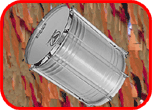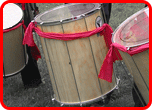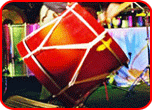
Drumming
Playing drums in a community of drummers
is a very positive experience. Each member is reliant on other members
of the group to create the sound of the 'bateria' . Each member has
a particular role to play in the overall structure of the music and.
this develops a sense of responsibility to 'get it right' so the band
can sound good, and when it sounds good so the players feel good..
The different instruments of a 'bateria' call upon different skills
and make different demands on the players. The lead instrument in
a samba 'bateria' is called a repinique. It is this instrument that
literally 'calls' the rest of the band into action with a short phrase.
It's sound is high pitched and it cuts through the rest of the rumble
of the bateria effectively (pictured above).
The 'heartbeat' of the bateria are the very low pitched large drums
called 'Surdo's'(pictured middle). The drums are very low in pitch
in contrast to the repinique. They have a thunderous sound.

Brazilian Carnival Drumming
The sound of many drummers playing together is an awesome sound and in
Brazil many hundreds of percussionists join together in 'bateria's' at
carnival time. The groups are so large that they need several musical
directors or 'maestre's' to keep the music together. In a parade the maestre's
are spaced along the long line of 'sambistas' to make sure the front of
the band is in synchronisation with the back. The large drums used at
carnival time are called 'surdo's' and are carried with a strap around
the neck.
The original 'semba' rhythm came from the Angola region of South East Africa and was brought to Brazil by the black slaves. 'Semba' was developed in Brazil by the black immigrants in the Bahia region of Brazil into the rhythms heard ar carnival time today. Batucada rhythms played at carnival time are characterized by their fast pace and repetition and are direct descendant's of the 'semba' rhythm.

Maracatu
This is a style of rhythm that originally came to the South Eastern
state of Pernabuco from Africa. Pernambuco is the nearest point in Brazil
to Africa. This rhythm is played on 'zazumba's' (see pic. above) which
are bass drums. The drum is hit with large wooden sticks and the rhythms
are very 'off-beat'. It's origins lie in the coronation of Kings of
the Congo. It was played in colonial times by slaves to celebrate their
leaders.
Candomble Drumming
Percussion instruments have strong ceremonial, sacred, or symbolic associations
in Brazil and in most tribal rituals throughout the world. 'Candomble'
houses in Brazil use the hypnotic sound of drumming to reach spiritual
states of awareness and to contact their gods or 'Orixas' The drums used
are called atabaque drums, are tall and are tensioned using a system of
ropes. These drums are sacred to the candomble community and players.